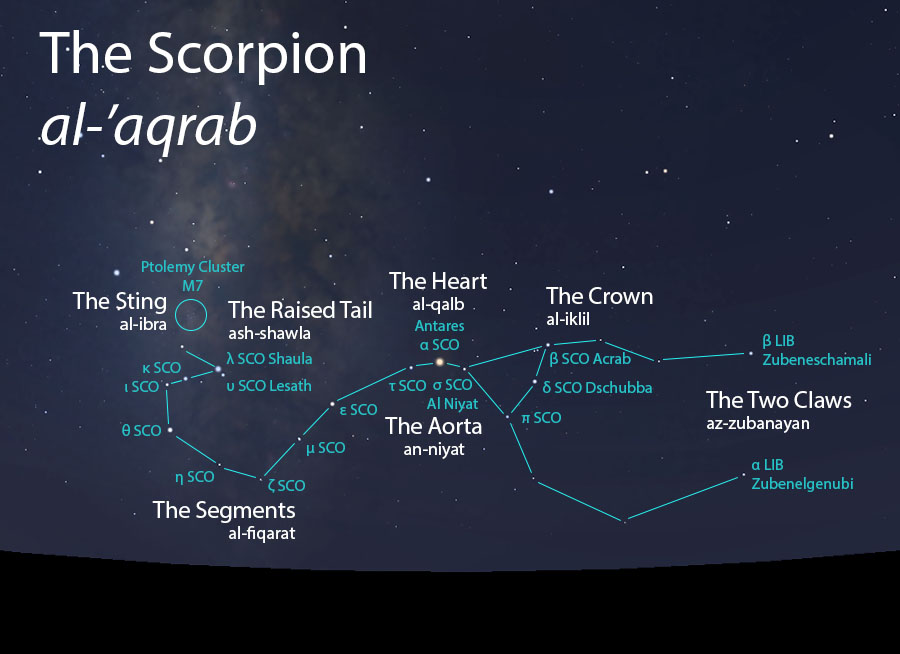Elements of the Celestial Complex
The Two Claws of the Scorpion (az-zubanayan, الزبانيان)
The Crown of the Scorpion (al-iklil, الإكليل)
The Heart of the Scorpion (al-qalb, القلب)
The Aorta (an-niyat, النياط)
The Segments (al-fiqarat, الفقرات)
The Raised Tail (ash-shawla, الشولة)
The Sting of the Scorpion (al-ibra, الإبرة)
The Arabian Scorpion followed the image of the scorpion defined by the Sumerians more than 3000 years ago. The Scorpion was well-defined with Two Claws, a Head (Crown), a Heart with its Aorta, Segments, a Raised Tail and a Sting.

The Scorpion (al-‘aqrab) as it appears setting in the west about 45 minutes before sunrise in mid-May. Sky simulations made with Stellarium.
Appearance
The Scorpion is an easy recognizable constellation that is largely consistent with modern-day Scorpius. In the west, its Claws extend into Libra, just as it was drawn in Mesopotamia thousands of years ago.
Modern Identification
The stars of the Claws and body:
β LIB (Zubeneschamali), blue-white star, magnitude 2.6
α LIB (Zubenelgenubi), blue-white double star, magnitudes 2.8 and 5.2
β SCO (Acrab), blue-white double star, magnitudes 2.6 and 4.9
δ SCO (Dschubba), blue-white star, magnitude 2.3
π SCO, blue-white star, magnitude 2.9
α SCO (Antares), red supergiant variable star, magnitude 0.9-1.1
σ SCO (Al-Niyat), blue-white star, magnitude 2.9
τ SCO, blue-white star, magnitude 2.8
The stars of the tail and Sting:
ε SCO, orange giant star, magnitude 2.3
μ SCO, blue double star, magnitudes 3.0 and 3.6
ζ SCO, white and orange multiple star system, magnitudes 4.9, 4.9, 7.2, 7.2 and 8.0
η SCO, yellow star, magnitude 3.3
θ SCO, yellow-white supergiant star, magnitude 1.9
ι SCO, yellow-white star, magnitude 3.0
κ SCO, blue star, magnitude 2.4
λ SCO (Shaula), blue-white star, magnitude 1.6
υ SCO (Lesath), blue-white star, magnitude 2.7
M7 (Ptolemy Cluster), star cluster, magnitude 3.3
Timing
The entire Scorpion, from its Two Claws to its Raised Tail and Sting set within a short period of a few weeks but rise over the course of almost two months. Today we can expect to observe the Scorpion setting in the west (about 45-60 minutes before sunrise) from late May through mid-June, as seen from the latitude of Tucson. Likewise, it rose from late November through mid-January.
Rain Stars
The Scorpion does not figure in the calendar of the rains stars.
Lunar Stations
The celestial complex of the Scorpion comprises four lunar stations. The earliest listings of the lunar stations were later adjusted backwards by two stations to adjust the calendar to begin with the vernal equinox. In what follows below, the earlier order is listed in parentheses.
16th (18th) lunar station: The Claw of the Scorpion (az-zubana)
17th (19th) lunar station: The Crown of the Scorpion (al-iklil)
18th (20th) lunar station: The Heart of the Scorpion (al-qalb)
19th (21st) lunar station: The Raised Tail (ash-shawla)

